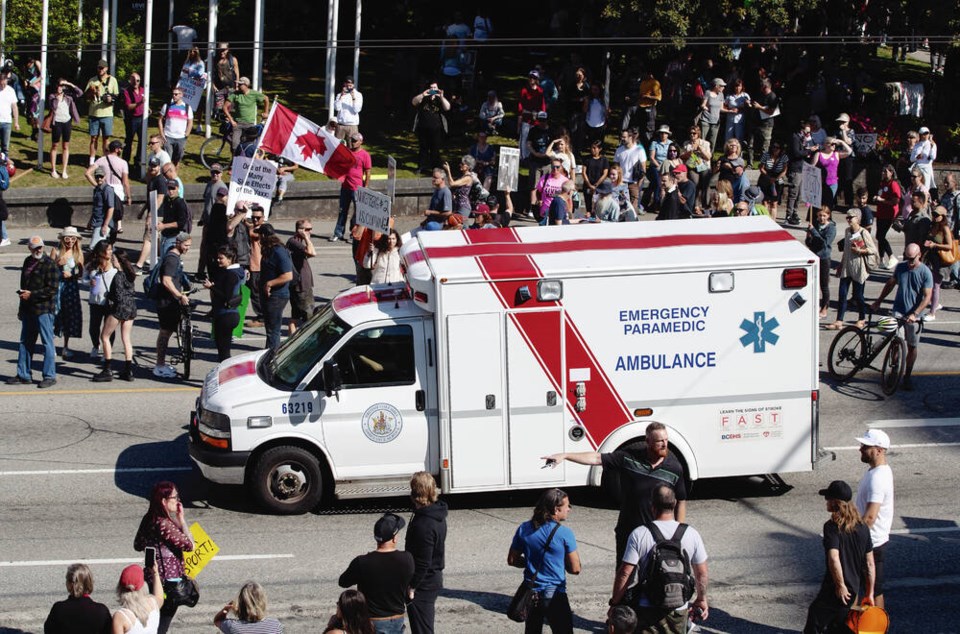Public Safety Minister Mike Farnworth says his government is considering bubble-zone legislation to prevent anti-vaccine protesters blocking access to hospitals and schools.
Farnworth made the remark after demonstrators entered three schools in the Salmon Arm area, causing the local school district to place all of its schools on lockdown.
These protests in turn followed mass rallies at hospitals in Victoria, Nanaimo and across the province. There were instances of violence, intimidation, and verbal abuse.
Staff and patients were forced to make their way through angry and raucous crowds. Health Minister Adrian Dix rightly called the protesters “despicable.”
Bubble zones have been used in B.C. before. During the 1980s and early 1990s, opponents of abortion swarmed the entryways to clinics where the procedure was performed, and harassed anyone entering or leaving.
Matters came to a head in 1995 when a Vancouver abortion provider, Dr. Garson Romalis, was shot through the window of his home, and nearly killed. After returning to work, he was stabbed in the back at his clinic. He also survived this attack.
Following the Romalis shooting, the NDP administration of the day passed the Access to Abortion Services Act. The statute set up three protected zones with, respectively, a radius of 160 metres from a service provider’s home, up to 50 metres from a clinic, and up to 10 metres from a doctor’s office.
Within these zones, it became an offence to protest or in any way interfere with people coming and going.
At the time, many legal experts had doubts as to the constitutional status of the act. But it survived several court challenges, and was upheld by the Supreme Court of Canada.
Five other provinces subsequently passed similar legislation, and two more have drafts under review.
However, the question arises, why is legislation needed? Can’t protesters at hospitals and schools be removed on the basis of existing statutes?
As things stand, there is a degree of uncertainty around this matter. Law-enforcement authorities have said that unless acts of violence occur, or entryways are actually blocked, they are powerless to intervene.
Moreover the question of what would constitute blocking access is open to interpretation. Hence the need for legislation to address what are, in effect, unprecedented challenges to public order.
Even so, the same difficulties that faced drafters of the bubble-zone act, still remain.
Courts are naturally concerned that the right of peaceful protest should not be curtailed. But what counts as “peaceful protest”?
Instinctively, we might say that a demonstration in front of the legislature should be permitted. Politicians must expect a certain amount of legitimate protest.
A demonstration in front of a school or hospital is another matter. There is a clear public interest, indeed necessity, in safeguarding facilities like these.
We can carry that point further. The abortion clinic protests, while offensive and deliberately intimidating, at least had some kind of logic. The protesters were trying to halt a procedure with which, on moral grounds, they disagreed.
What possible connection is there between a hospital or school, and the vaccine policies or mask-wearing requirements those protesters disagree with?
Their dispute is with politicians and public health officers, not innocent nursing staff or teachers.
However, it is not only physical access that is at stake.
Staff who work in these facilities, and the patients and pupils who attend them, are entitled to more than having a riotous crowd moved back a certain distance.
They are entitled to know that society won’t tolerate, in any degree, the abuse we’ve seen hurled at them.
Whatever legislation is drafted must deal in more than metres and zones. It must make clear that intimidation of any kind will not be tolerated.
How this is to be accomplished, while still safeguarding the basic right to protest, is the constitutional challenge of the day.



